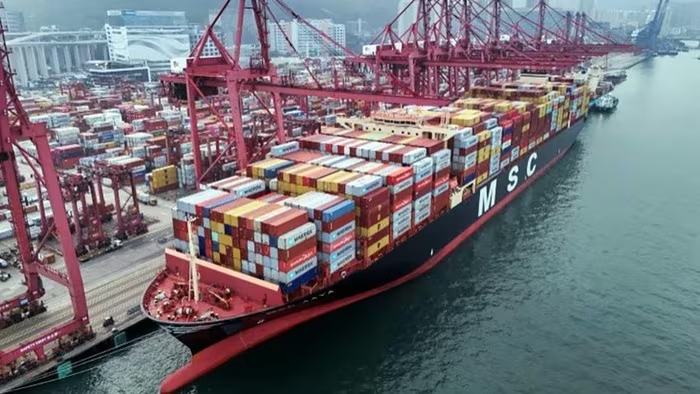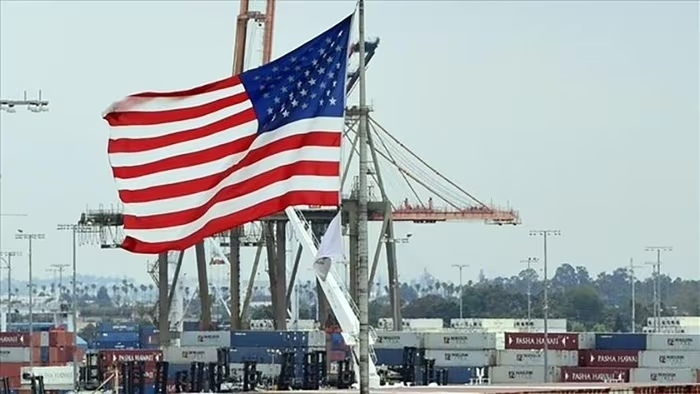Only about a month remains before the deadline for the U.S. and China to reach a trade agreement, yet the conflict is escalating and has now entered a new front — no longer limited to tariffs on goods or electronic components but extending to seaports, the lifelines of global trade. Starting from October 14, both the U.S. and China have imposed retaliatory port fees on each other’s vessels.
As U.S.-China trade tensions evolve into deeper strategic competition, maritime transport — the backbone of global commerce — has become the “new battleground” between the world’s two largest economies. The simultaneous imposition of retaliatory port charges by Washington and Beijing on each other’s commercial ships marks not only an escalation in their economic confrontation but also an expansion of conflict into global infrastructure and supply chain domains.

A view of a container terminal in Hong Kong, China – Photo: Reuters
Right after the policy announcement, China’s Ministry of Commerce condemned the U.S. action as “unilateral” and “protectionist,” claiming it violates WTO rules and seriously harms China’s maritime industry. The Ministry of Transport asserted that imposing port fees on U.S. ships is “lawful and justified,” aimed at protecting domestic enterprises and maintaining fair international competition. China’s General Administration of Customs also described the move as a necessary safeguard measure to ensure fairness for Chinese companies.
According to Beijing-based observers, China’s underlying goal is to pressure the U.S. into adjusting its policies and returning to negotiations on the basis of mutual respect, while indirectly forcing international shipping companies to reconsider their routes to avoid rising costs on both sides.
Many Chinese scholars and experts also reject the reasons cited by the U.S. Mr. Ha Weiwen, a senior researcher at the Center for China and Globalization, argued that the U.S. justification of protecting its shipbuilding industry and ensuring national security is “completely unreasonable,” since the scale of U.S. shipyards is only about 1/60 that of China’s, and port fees are related to transport operations rather than shipbuilding. He warned that Washington’s actions are intended to “suppress Chinese industry at all costs, even at the expense of harming itself.”
Analysts in Beijing also noted that both countries now view port fees as a new form of strategic competition rather than traditional import-export tariffs. The sudden inclusion of port fees in the “trade war toolbox” reflects the central role of maritime transport in global supply chains — any impact on port fees ripples through shipping costs and ultimately affects consumer prices. Many experts warn that such measures could “lock both economies into a maritime tariff spiral” and “distort global trade flows.”
In essence, port fees are being treated by China as a “soft weapon” — allowing Beijing to retaliate without immediately escalating standard tariffs, while demonstrating its ability to influence key nodes in global trade. With both superpowers simultaneously imposing port charges on each other’s fleets, global supply chains now face serious risks of disruption. From Beijing’s perspective, U.S. port fees on Chinese vessels represent an act of “economic coercion” targeting one of China’s foundational industries.
According to Chinese estimates, major carriers such as COSCO Shipping will be hit the hardest — potentially bearing nearly half of the estimated USD 3.2 billion in port fees the U.S. expects to collect in 2026. However, Beijing considers these short-term losses manageable.
State-owned shipping conglomerates in China have been encouraged to adjust their routes, change transshipment ports, and shift part of the additional costs to international clients in order to maintain stable operations. Moreover, the Ministry of Transport has introduced domestic port fee reductions and credit support to help sustain competitiveness. Beijing-based experts regard this as a “resilience test” for China’s maritime industry amid a harsher global trade environment.
For China’s export sector, the new port fees do not directly tax goods but increase logistics costs and transit times, indirectly eroding exporters’ profit margins. Chinese economists suggest that the impact will be selective: low-margin sectors dependent on U.S. routes — such as consumer goods, furniture, and low-cost electronics — will face the most pressure, while high-value industries like machinery, batteries, and new energy products will be less affected.
Research institutes in Beijing believe the overall impact is “manageable,” as supply chains are being redirected with many Chinese firms expanding exports to Asia, the Middle East, Africa, and Latin America. Diversifying maritime routes and trade partners serves as a “strategic buffer” that helps China mitigate the ripple effects of U.S. measures.
On a global scale, with over 80% of world trade moving by sea, simultaneous port fee hikes by the U.S. and China are seen by Chinese scholars as a “global cost shock.” As port and shipping rates rise, the entire international supply chain — from raw materials to consumer goods — faces inflationary pressure.

The U.S. economy could lose up to USD 1 trillion in the long term if it decouples from China – Illustration: AFP
Chinese experts emphasize that the average 5–10% increase in logistics costs could spread through a “domino effect,” pushing up export prices and ultimately burdening consumers in the U.S. and Europe. From Beijing’s perspective, this is a “policy backlash” against Washington, as higher domestic prices could fuel inflation and hurt the competitiveness of American firms.
In the medium term, China expects global markets to self-adjust through the restructuring of transport networks, rerouting goods via ports unaffected by the new fees or through alternative maritime pathways. However, experts warn that if the trend of “weaponizing maritime transport” continues, global logistics costs could remain elevated for an extended period, undermining the recovery of world trade.
From Beijing’s viewpoint, the port fee policy poses a short-term challenge but also a long-term opportunity to enhance maritime self-reliance, reduce dependence on U.S. ports and sea routes, and accelerate the modernization of China’s domestic logistics sector through digitalization, operational optimization, and investment in port infrastructure. More importantly, Beijing seeks to turn this crisis into a political lever — demonstrating China’s “resilience and adaptability” under external pressure, and signaling that “any economic coercion against China will come at a proportional cost.”